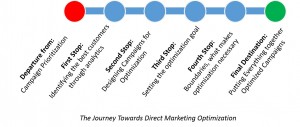Today most companies engage in direct marketing to communicate with their customers. If you work on a campaign management team, you are probably sending emails, SMS, letters (you can admit it - you are still doing it!) and also using call centers in order to extend offers to your customers.
Some companies use analytics to choose their targets in a data driven way, while others rely their business knowledge and mostly use rules to do so. Furthermore, in the same company the strategy can vary among Product Lines or Departments. Whichever your case is, all companies face the same problem: too many offers for too few customers and limited resources.
The need for prioritization
When selecting targets for the different offers, it can happen than a client can be eligible for more than one campaign. In a "perfect" world we'd have unlimited call center agents, an unlimited marketing budget and customers would not mind being contacted many times with multiple offers or even the same offer over and over. As we all know, that kind of "perfect" world doesn't exist.
Most of the companies we work with develop prioritization strategies in order to decide which offer the customer receives. Prioritization is a hierarchical approach that usually involves creating rules to pick customers for each campaign. Although prioritization mostly handles contact policy restrictions, it usually does not take into account overall marketing results. We can illustrate this situation with a very simple example.
Consider the scenario where there are two offers that can be extended to two customers. We know the value we could get from each offer if the customer accepts the offer and we also know the probability or response rate for this offer.
Observing business restrictions
In a perfect world, we could get a value of 265 (the sum of all the offers). But as said before, the world is not perfect. Companies have some business constraints that campaign managers should consider when selecting the audience. The most usual constraint is the contact policy. Most of the companies have in place contact strategies so as not to saturate their clients. In this example, we will consider we can contact the customer only once in the period. The solution in this case would be to choose for each client the most valuable offer. This can be considered a Maximization strategy. By doing so, Customer 1 and 2 would receive Offer 1 and we could get 160 profit. However, the product manager of Offer 2 will need some prospects in order to reach his sales goals, so he will claim a minimum amount of customers for his campaign. To fulfill these new requirements, we follow a hierarchical process were we choose for each offer, the best customer. If we start by offer 1, then we would get 115 profit, as each customer can only receive one offer.
The optimization algorithm
None of these approaches is the optimal one. By working with an optimization algorithm that considers all the possible combinations regarding the constraints, we could get 150 profit (offer 2 for customer 1 and offer 1 for customer 2).
Extrapolate now this problem to your real life situation with millions of customers, dozens of campaigns, several channels, and limited marketing budget. The possible combinations are huge. We can only solve it using advanced algorithms.
Did your eyes glaze over after reading the word algorithm above? Mentioning the word algorithm in a marketing environment can be discouraging. Have no fear - marketers do not need to have programming skills or mathematical knowledge in order to optimize their campaigns. By using SAS Marketing Optimization, campaign managers can easily find the best solution for their problem without needing to code.
Optimization is a journey
 This is the first of a series of blog posts where I will cover all the necessary steps to reach an optimal campaign solution. I will start by explaining how to understand the potential of each customer for each offer using basic and advanced analytics. Then I will talk about how to design campaigns for an optimization process, as this will probably mean some cultural change. After, I will discuss about the optimization objective. Should we maximize revenue? Should we minimize costs? Or should we do both? We only need to optimize if we have restrictions, so I will write about the kind of constraints we can handle and the most common ones we see in different industries. With all this, the final article will be about how to put everything together.
This is the first of a series of blog posts where I will cover all the necessary steps to reach an optimal campaign solution. I will start by explaining how to understand the potential of each customer for each offer using basic and advanced analytics. Then I will talk about how to design campaigns for an optimization process, as this will probably mean some cultural change. After, I will discuss about the optimization objective. Should we maximize revenue? Should we minimize costs? Or should we do both? We only need to optimize if we have restrictions, so I will write about the kind of constraints we can handle and the most common ones we see in different industries. With all this, the final article will be about how to put everything together.
Stay tuned for the next step in this journey toward optimization - it's the way to better marketing.

5 Comments
Pingback: Optimization step 1: identify the best customers - Customer Analytics
Pingback: Optimization step 2: designing campaigns - Customer Analytics
Pingback: Optimization step 3: setting the goal - Customer Analytics
Pingback: Optimization step 4: setting the right boundaries - Customer Analytics
Pingback: Optimization step 5: putting everything together - Customer Analytics